2003 DODGE RAM Speed sensor
[x] Cancel search: Speed sensorPage 2526 of 2895
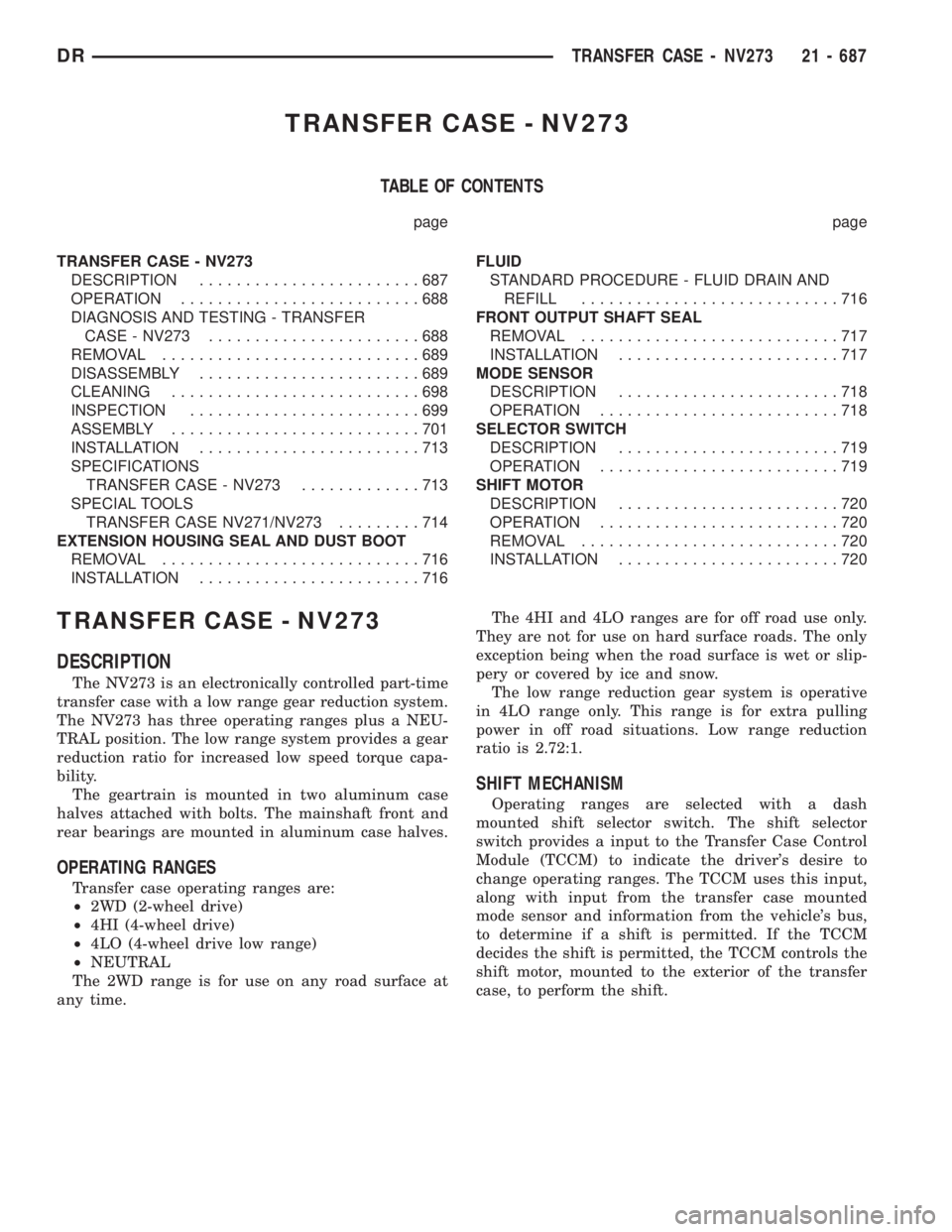
TRANSFER CASE - NV273
TABLE OF CONTENTS
page page
TRANSFER CASE - NV273
DESCRIPTION........................687
OPERATION..........................688
DIAGNOSIS AND TESTING - TRANSFER
CASE - NV273.......................688
REMOVAL............................689
DISASSEMBLY........................689
CLEANING...........................698
INSPECTION.........................699
ASSEMBLY...........................701
INSTALLATION........................713
SPECIFICATIONS
TRANSFER CASE - NV273.............713
SPECIAL TOOLS
TRANSFER CASE NV271/NV273.........714
EXTENSION HOUSING SEAL AND DUST BOOT
REMOVAL............................716
INSTALLATION........................716FLUID
STANDARD PROCEDURE - FLUID DRAIN AND
REFILL............................716
FRONT OUTPUT SHAFT SEAL
REMOVAL............................717
INSTALLATION........................717
MODE SENSOR
DESCRIPTION........................718
OPERATION..........................718
SELECTOR SWITCH
DESCRIPTION........................719
OPERATION..........................719
SHIFT MOTOR
DESCRIPTION........................720
OPERATION..........................720
REMOVAL............................720
INSTALLATION........................720
TRANSFER CASE - NV273
DESCRIPTION
The NV273 is an electronically controlled part-time
transfer case with a low range gear reduction system.
The NV273 has three operating ranges plus a NEU-
TRAL position. The low range system provides a gear
reduction ratio for increased low speed torque capa-
bility.
The geartrain is mounted in two aluminum case
halves attached with bolts. The mainshaft front and
rear bearings are mounted in aluminum case halves.
OPERATING RANGES
Transfer case operating ranges are:
²2WD (2-wheel drive)
²4HI (4-wheel drive)
²4LO (4-wheel drive low range)
²NEUTRAL
The 2WD range is for use on any road surface at
any time.The 4HI and 4LO ranges are for off road use only.
They are not for use on hard surface roads. The only
exception being when the road surface is wet or slip-
pery or covered by ice and snow.
The low range reduction gear system is operative
in 4LO range only. This range is for extra pulling
power in off road situations. Low range reduction
ratio is 2.72:1.
SHIFT MECHANISM
Operating ranges are selected with a dash
mounted shift selector switch. The shift selector
switch provides a input to the Transfer Case Control
Module (TCCM) to indicate the driver's desire to
change operating ranges. The TCCM uses this input,
along with input from the transfer case mounted
mode sensor and information from the vehicle's bus,
to determine if a shift is permitted. If the TCCM
decides the shift is permitted, the TCCM controls the
shift motor, mounted to the exterior of the transfer
case, to perform the shift.
DRTRANSFER CASE - NV273 21 - 687
Page 2559 of 2895
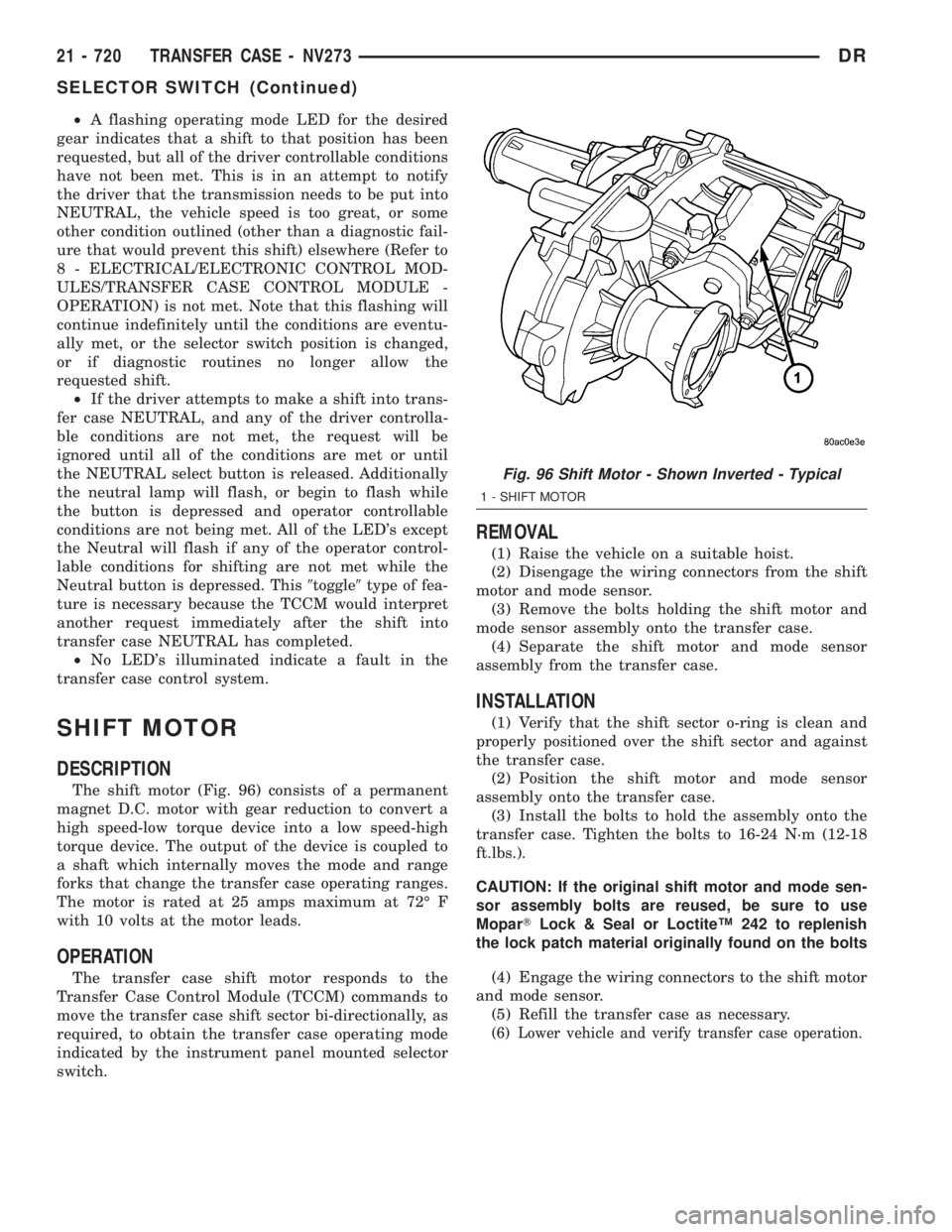
²A flashing operating mode LED for the desired
gear indicates that a shift to that position has been
requested, but all of the driver controllable conditions
have not been met. This is in an attempt to notify
the driver that the transmission needs to be put into
NEUTRAL, the vehicle speed is too great, or some
other condition outlined (other than a diagnostic fail-
ure that would prevent this shift) elsewhere (Refer to
8 - ELECTRICAL/ELECTRONIC CONTROL MOD-
ULES/TRANSFER CASE CONTROL MODULE -
OPERATION) is not met. Note that this flashing will
continue indefinitely until the conditions are eventu-
ally met, or the selector switch position is changed,
or if diagnostic routines no longer allow the
requested shift.
²If the driver attempts to make a shift into trans-
fer case NEUTRAL, and any of the driver controlla-
ble conditions are not met, the request will be
ignored until all of the conditions are met or until
the NEUTRAL select button is released. Additionally
the neutral lamp will flash, or begin to flash while
the button is depressed and operator controllable
conditions are not being met. All of the LED's except
the Neutral will flash if any of the operator control-
lable conditions for shifting are not met while the
Neutral button is depressed. This9toggle9type of fea-
ture is necessary because the TCCM would interpret
another request immediately after the shift into
transfer case NEUTRAL has completed.
²No LED's illuminated indicate a fault in the
transfer case control system.
SHIFT MOTOR
DESCRIPTION
The shift motor (Fig. 96) consists of a permanent
magnet D.C. motor with gear reduction to convert a
high speed-low torque device into a low speed-high
torque device. The output of the device is coupled to
a shaft which internally moves the mode and range
forks that change the transfer case operating ranges.
The motor is rated at 25 amps maximum at 72É F
with 10 volts at the motor leads.
OPERATION
The transfer case shift motor responds to the
Transfer Case Control Module (TCCM) commands to
move the transfer case shift sector bi-directionally, as
required, to obtain the transfer case operating mode
indicated by the instrument panel mounted selector
switch.
REMOVAL
(1) Raise the vehicle on a suitable hoist.
(2) Disengage the wiring connectors from the shift
motor and mode sensor.
(3) Remove the bolts holding the shift motor and
mode sensor assembly onto the transfer case.
(4) Separate the shift motor and mode sensor
assembly from the transfer case.
INSTALLATION
(1) Verify that the shift sector o-ring is clean and
properly positioned over the shift sector and against
the transfer case.
(2) Position the shift motor and mode sensor
assembly onto the transfer case.
(3) Install the bolts to hold the assembly onto the
transfer case. Tighten the bolts to 16-24 N´m (12-18
ft.lbs.).
CAUTION: If the original shift motor and mode sen-
sor assembly bolts are reused, be sure to use
MoparTLock & Seal or LoctiteŸ 242 to replenish
the lock patch material originally found on the bolts
(4) Engage the wiring connectors to the shift motor
and mode sensor.
(5) Refill the transfer case as necessary.
(6) Lower vehicle and verify transfer case operation.
Fig. 96 Shift Motor - Shown Inverted - Typical
1 - SHIFT MOTOR
21 - 720 TRANSFER CASE - NV273DR
SELECTOR SWITCH (Continued)
Page 2782 of 2895
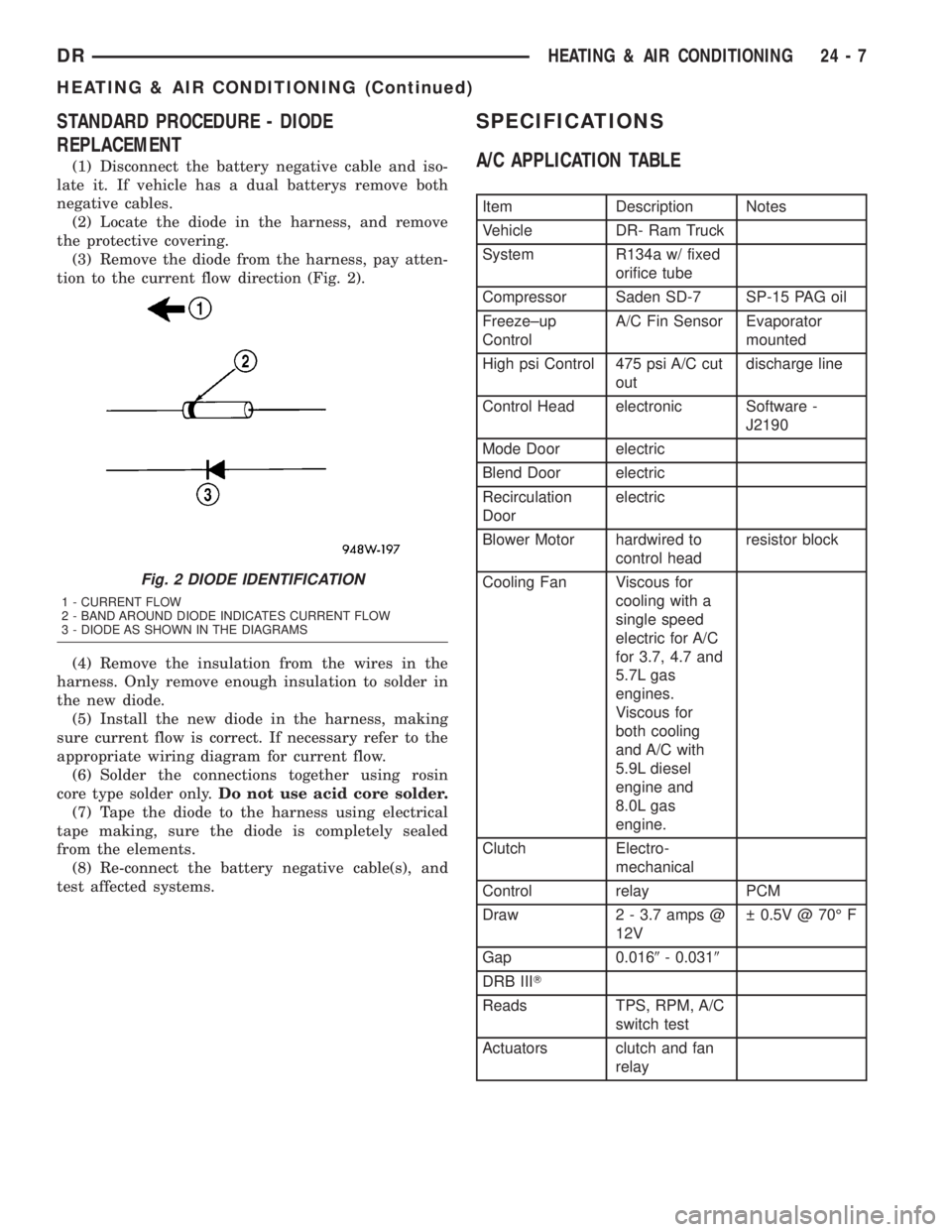
STANDARD PROCEDURE - DIODE
REPLACEMENT
(1) Disconnect the battery negative cable and iso-
late it. If vehicle has a dual batterys remove both
negative cables.
(2) Locate the diode in the harness, and remove
the protective covering.
(3) Remove the diode from the harness, pay atten-
tion to the current flow direction (Fig. 2).
(4) Remove the insulation from the wires in the
harness. Only remove enough insulation to solder in
the new diode.
(5) Install the new diode in the harness, making
sure current flow is correct. If necessary refer to the
appropriate wiring diagram for current flow.
(6) Solder the connections together using rosin
core type solder only.Do not use acid core solder.
(7) Tape the diode to the harness using electrical
tape making, sure the diode is completely sealed
from the elements.
(8) Re-connect the battery negative cable(s), and
test affected systems.
SPECIFICATIONS
A/C APPLICATION TABLE
Item Description Notes
Vehicle DR- Ram Truck
System R134a w/ fixed
orifice tube
Compressor Saden SD-7 SP-15 PAG oil
Freeze±up
ControlA/C Fin Sensor Evaporator
mounted
High psi Control 475 psi A/C cut
outdischarge line
Control Head electronic Software -
J2190
Mode Door electric
Blend Door electric
Recirculation
Doorelectric
Blower Motor hardwired to
control headresistor block
Cooling Fan Viscous for
cooling with a
single speed
electric for A/C
for 3.7, 4.7 and
5.7L gas
engines.
Viscous for
both cooling
and A/C with
5.9L diesel
engine and
8.0L gas
engine.
Clutch Electro-
mechanical
Control relay PCM
Draw 2 - 3.7 amps @
12V 0.5V @ 70É F
Gap 0.0169- 0.0319
DRB IIIT
Reads TPS, RPM, A/C
switch test
Actuators clutch and fan
relay
Fig. 2 DIODE IDENTIFICATION
1 - CURRENT FLOW
2 - BAND AROUND DIODE INDICATES CURRENT FLOW
3 - DIODE AS SHOWN IN THE DIAGRAMS
DRHEATING & AIR CONDITIONING 24 - 7
HEATING & AIR CONDITIONING (Continued)
Page 2790 of 2895
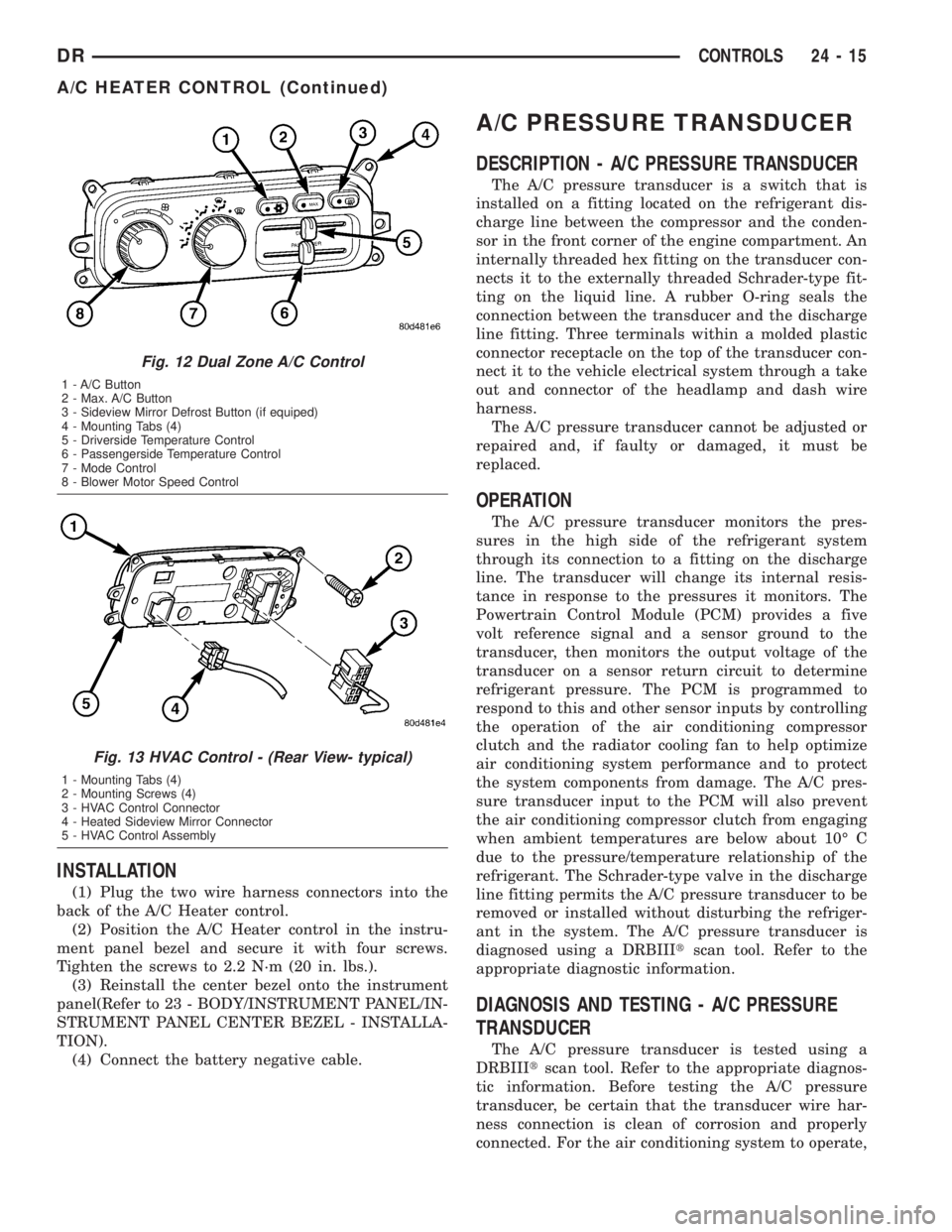
INSTALLATION
(1) Plug the two wire harness connectors into the
back of the A/C Heater control.
(2) Position the A/C Heater control in the instru-
ment panel bezel and secure it with four screws.
Tighten the screws to 2.2 N´m (20 in. lbs.).
(3) Reinstall the center bezel onto the instrument
panel(Refer to 23 - BODY/INSTRUMENT PANEL/IN-
STRUMENT PANEL CENTER BEZEL - INSTALLA-
TION).
(4) Connect the battery negative cable.
A/C PRESSURE TRANSDUCER
DESCRIPTION - A/C PRESSURE TRANSDUCER
The A/C pressure transducer is a switch that is
installed on a fitting located on the refrigerant dis-
charge line between the compressor and the conden-
sor in the front corner of the engine compartment. An
internally threaded hex fitting on the transducer con-
nects it to the externally threaded Schrader-type fit-
ting on the liquid line. A rubber O-ring seals the
connection between the transducer and the discharge
line fitting. Three terminals within a molded plastic
connector receptacle on the top of the transducer con-
nect it to the vehicle electrical system through a take
out and connector of the headlamp and dash wire
harness.
The A/C pressure transducer cannot be adjusted or
repaired and, if faulty or damaged, it must be
replaced.
OPERATION
The A/C pressure transducer monitors the pres-
sures in the high side of the refrigerant system
through its connection to a fitting on the discharge
line. The transducer will change its internal resis-
tance in response to the pressures it monitors. The
Powertrain Control Module (PCM) provides a five
volt reference signal and a sensor ground to the
transducer, then monitors the output voltage of the
transducer on a sensor return circuit to determine
refrigerant pressure. The PCM is programmed to
respond to this and other sensor inputs by controlling
the operation of the air conditioning compressor
clutch and the radiator cooling fan to help optimize
air conditioning system performance and to protect
the system components from damage. The A/C pres-
sure transducer input to the PCM will also prevent
the air conditioning compressor clutch from engaging
when ambient temperatures are below about 10É C
due to the pressure/temperature relationship of the
refrigerant. The Schrader-type valve in the discharge
line fitting permits the A/C pressure transducer to be
removed or installed without disturbing the refriger-
ant in the system. The A/C pressure transducer is
diagnosed using a DRBIIItscan tool. Refer to the
appropriate diagnostic information.
DIAGNOSIS AND TESTING - A/C PRESSURE
TRANSDUCER
The A/C pressure transducer is tested using a
DRBIIItscan tool. Refer to the appropriate diagnos-
tic information. Before testing the A/C pressure
transducer, be certain that the transducer wire har-
ness connection is clean of corrosion and properly
connected. For the air conditioning system to operate,
Fig. 12 Dual Zone A/C Control
1 - A/C Button
2 - Max. A/C Button
3 - Sideview Mirror Defrost Button (if equiped)
4 - Mounting Tabs (4)
5 - Driverside Temperature Control
6 - Passengerside Temperature Control
7 - Mode Control
8 - Blower Motor Speed Control
Fig. 13 HVAC Control - (Rear View- typical)
1 - Mounting Tabs (4)
2 - Mounting Screws (4)
3 - HVAC Control Connector
4 - Heated Sideview Mirror Connector
5 - HVAC Control Assembly
DRCONTROLS 24 - 15
A/C HEATER CONTROL (Continued)
Page 2800 of 2895
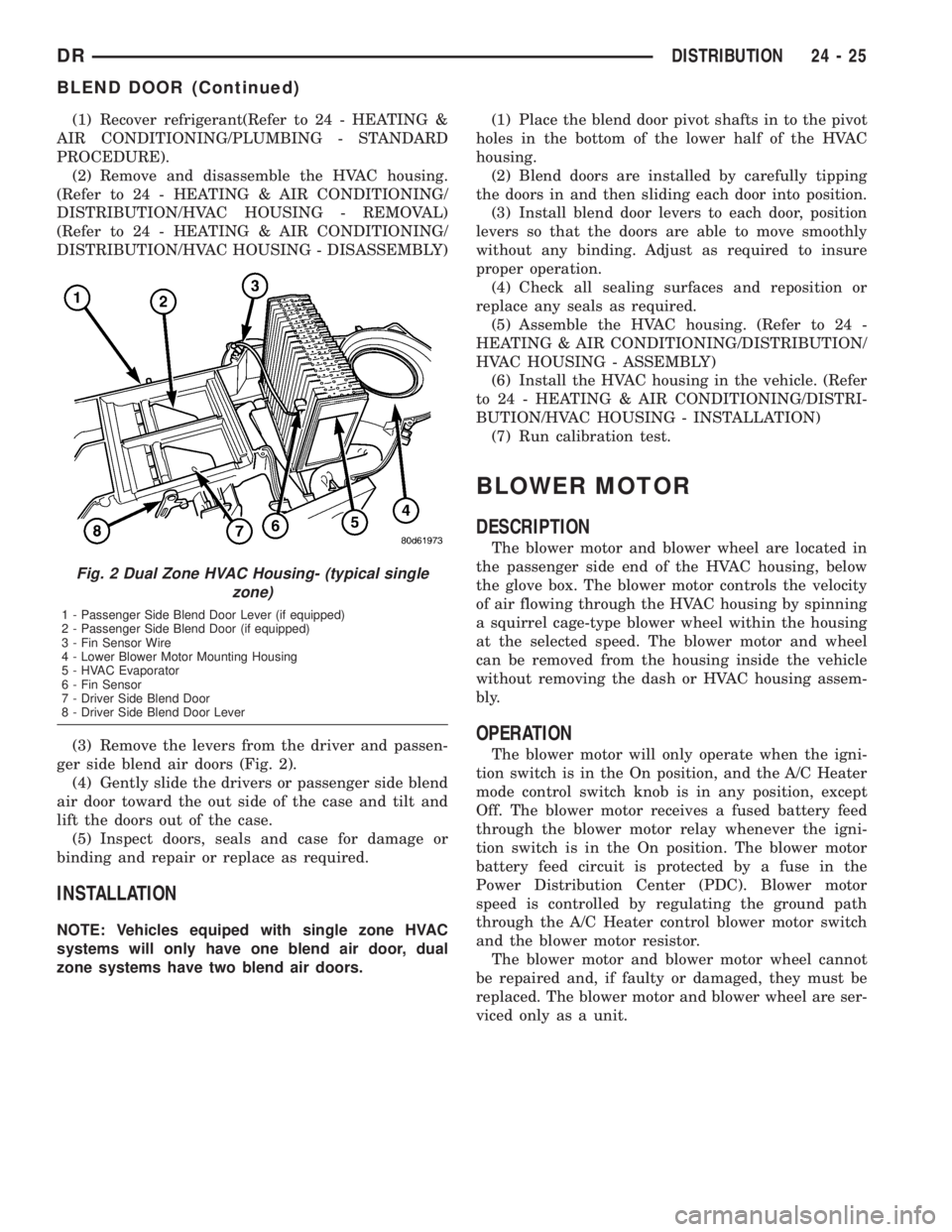
(1) Recover refrigerant(Refer to 24 - HEATING &
AIR CONDITIONING/PLUMBING - STANDARD
PROCEDURE).
(2) Remove and disassemble the HVAC housing.
(Refer to 24 - HEATING & AIR CONDITIONING/
DISTRIBUTION/HVAC HOUSING - REMOVAL)
(Refer to 24 - HEATING & AIR CONDITIONING/
DISTRIBUTION/HVAC HOUSING - DISASSEMBLY)
(3) Remove the levers from the driver and passen-
ger side blend air doors (Fig. 2).
(4) Gently slide the drivers or passenger side blend
air door toward the out side of the case and tilt and
lift the doors out of the case.
(5) Inspect doors, seals and case for damage or
binding and repair or replace as required.
INSTALLATION
NOTE: Vehicles equiped with single zone HVAC
systems will only have one blend air door, dual
zone systems have two blend air doors.(1) Place the blend door pivot shafts in to the pivot
holes in the bottom of the lower half of the HVAC
housing.
(2) Blend doors are installed by carefully tipping
the doors in and then sliding each door into position.
(3) Install blend door levers to each door, position
levers so that the doors are able to move smoothly
without any binding. Adjust as required to insure
proper operation.
(4) Check all sealing surfaces and reposition or
replace any seals as required.
(5) Assemble the HVAC housing. (Refer to 24 -
HEATING & AIR CONDITIONING/DISTRIBUTION/
HVAC HOUSING - ASSEMBLY)
(6) Install the HVAC housing in the vehicle. (Refer
to 24 - HEATING & AIR CONDITIONING/DISTRI-
BUTION/HVAC HOUSING - INSTALLATION)
(7) Run calibration test.
BLOWER MOTOR
DESCRIPTION
The blower motor and blower wheel are located in
the passenger side end of the HVAC housing, below
the glove box. The blower motor controls the velocity
of air flowing through the HVAC housing by spinning
a squirrel cage-type blower wheel within the housing
at the selected speed. The blower motor and wheel
can be removed from the housing inside the vehicle
without removing the dash or HVAC housing assem-
bly.
OPERATION
The blower motor will only operate when the igni-
tion switch is in the On position, and the A/C Heater
mode control switch knob is in any position, except
Off. The blower motor receives a fused battery feed
through the blower motor relay whenever the igni-
tion switch is in the On position. The blower motor
battery feed circuit is protected by a fuse in the
Power Distribution Center (PDC). Blower motor
speed is controlled by regulating the ground path
through the A/C Heater control blower motor switch
and the blower motor resistor.
The blower motor and blower motor wheel cannot
be repaired and, if faulty or damaged, they must be
replaced. The blower motor and blower wheel are ser-
viced only as a unit.
Fig. 2 Dual Zone HVAC Housing- (typical single
zone)
1 - Passenger Side Blend Door Lever (if equipped)
2 - Passenger Side Blend Door (if equipped)
3 - Fin Sensor Wire
4 - Lower Blower Motor Mounting Housing
5 - HVAC Evaporator
6 - Fin Sensor
7 - Driver Side Blend Door
8 - Driver Side Blend Door Lever
DRDISTRIBUTION 24 - 25
BLEND DOOR (Continued)
Page 2832 of 2895
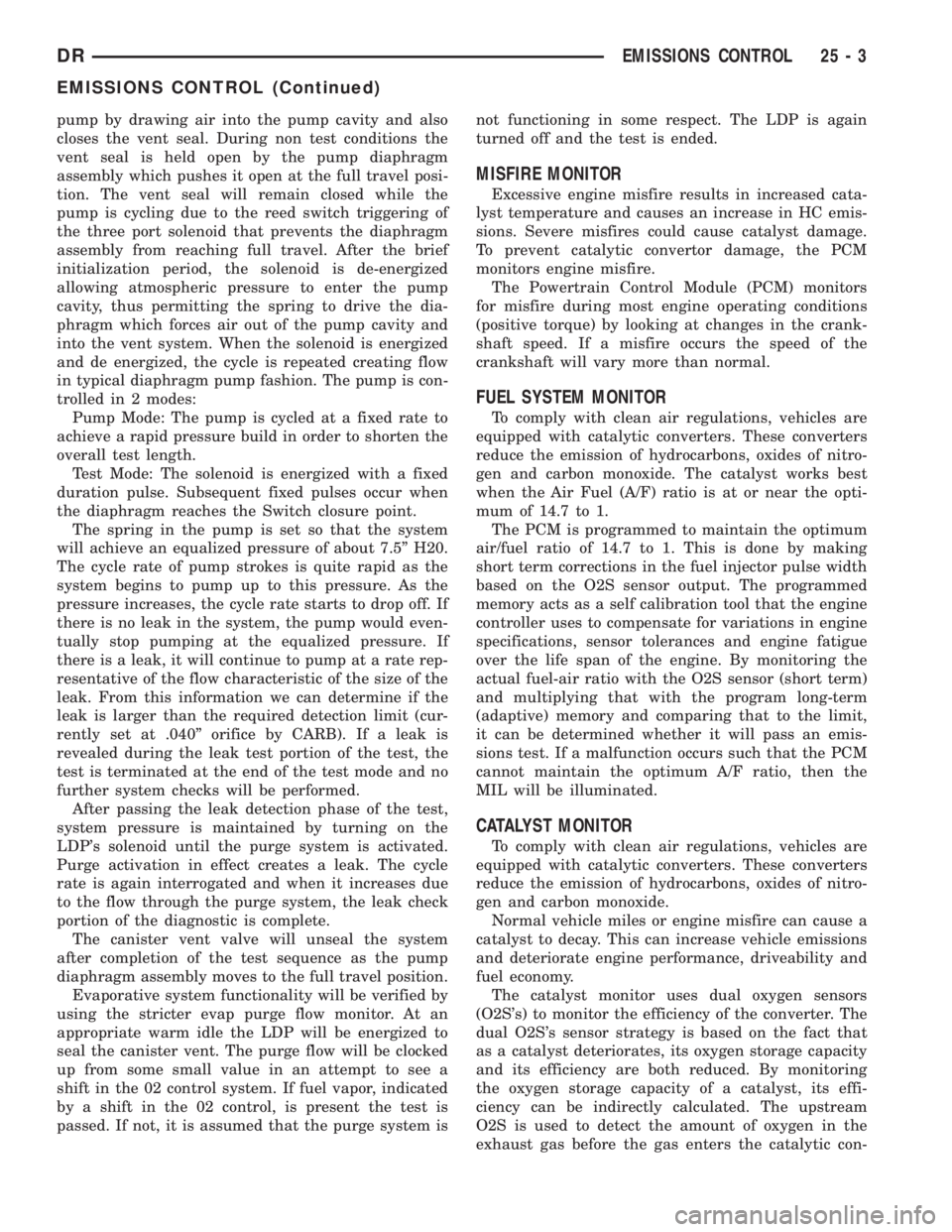
pump by drawing air into the pump cavity and also
closes the vent seal. During non test conditions the
vent seal is held open by the pump diaphragm
assembly which pushes it open at the full travel posi-
tion. The vent seal will remain closed while the
pump is cycling due to the reed switch triggering of
the three port solenoid that prevents the diaphragm
assembly from reaching full travel. After the brief
initialization period, the solenoid is de-energized
allowing atmospheric pressure to enter the pump
cavity, thus permitting the spring to drive the dia-
phragm which forces air out of the pump cavity and
into the vent system. When the solenoid is energized
and de energized, the cycle is repeated creating flow
in typical diaphragm pump fashion. The pump is con-
trolled in 2 modes:
Pump Mode: The pump is cycled at a fixed rate to
achieve a rapid pressure build in order to shorten the
overall test length.
Test Mode: The solenoid is energized with a fixed
duration pulse. Subsequent fixed pulses occur when
the diaphragm reaches the Switch closure point.
The spring in the pump is set so that the system
will achieve an equalized pressure of about 7.5º H20.
The cycle rate of pump strokes is quite rapid as the
system begins to pump up to this pressure. As the
pressure increases, the cycle rate starts to drop off. If
there is no leak in the system, the pump would even-
tually stop pumping at the equalized pressure. If
there is a leak, it will continue to pump at a rate rep-
resentative of the flow characteristic of the size of the
leak. From this information we can determine if the
leak is larger than the required detection limit (cur-
rently set at .040º orifice by CARB). If a leak is
revealed during the leak test portion of the test, the
test is terminated at the end of the test mode and no
further system checks will be performed.
After passing the leak detection phase of the test,
system pressure is maintained by turning on the
LDP's solenoid until the purge system is activated.
Purge activation in effect creates a leak. The cycle
rate is again interrogated and when it increases due
to the flow through the purge system, the leak check
portion of the diagnostic is complete.
The canister vent valve will unseal the system
after completion of the test sequence as the pump
diaphragm assembly moves to the full travel position.
Evaporative system functionality will be verified by
using the stricter evap purge flow monitor. At an
appropriate warm idle the LDP will be energized to
seal the canister vent. The purge flow will be clocked
up from some small value in an attempt to see a
shift in the 02 control system. If fuel vapor, indicated
by a shift in the 02 control, is present the test is
passed. If not, it is assumed that the purge system isnot functioning in some respect. The LDP is again
turned off and the test is ended.
MISFIRE MONITOR
Excessive engine misfire results in increased cata-
lyst temperature and causes an increase in HC emis-
sions. Severe misfires could cause catalyst damage.
To prevent catalytic convertor damage, the PCM
monitors engine misfire.
The Powertrain Control Module (PCM) monitors
for misfire during most engine operating conditions
(positive torque) by looking at changes in the crank-
shaft speed. If a misfire occurs the speed of the
crankshaft will vary more than normal.
FUEL SYSTEM MONITOR
To comply with clean air regulations, vehicles are
equipped with catalytic converters. These converters
reduce the emission of hydrocarbons, oxides of nitro-
gen and carbon monoxide. The catalyst works best
when the Air Fuel (A/F) ratio is at or near the opti-
mum of 14.7 to 1.
The PCM is programmed to maintain the optimum
air/fuel ratio of 14.7 to 1. This is done by making
short term corrections in the fuel injector pulse width
based on the O2S sensor output. The programmed
memory acts as a self calibration tool that the engine
controller uses to compensate for variations in engine
specifications, sensor tolerances and engine fatigue
over the life span of the engine. By monitoring the
actual fuel-air ratio with the O2S sensor (short term)
and multiplying that with the program long-term
(adaptive) memory and comparing that to the limit,
it can be determined whether it will pass an emis-
sions test. If a malfunction occurs such that the PCM
cannot maintain the optimum A/F ratio, then the
MIL will be illuminated.
CATALYST MONITOR
To comply with clean air regulations, vehicles are
equipped with catalytic converters. These converters
reduce the emission of hydrocarbons, oxides of nitro-
gen and carbon monoxide.
Normal vehicle miles or engine misfire can cause a
catalyst to decay. This can increase vehicle emissions
and deteriorate engine performance, driveability and
fuel economy.
The catalyst monitor uses dual oxygen sensors
(O2S's) to monitor the efficiency of the converter. The
dual O2S's sensor strategy is based on the fact that
as a catalyst deteriorates, its oxygen storage capacity
and its efficiency are both reduced. By monitoring
the oxygen storage capacity of a catalyst, its effi-
ciency can be indirectly calculated. The upstream
O2S is used to detect the amount of oxygen in the
exhaust gas before the gas enters the catalytic con-
DREMISSIONS CONTROL 25 - 3
EMISSIONS CONTROL (Continued)
Page 2834 of 2895
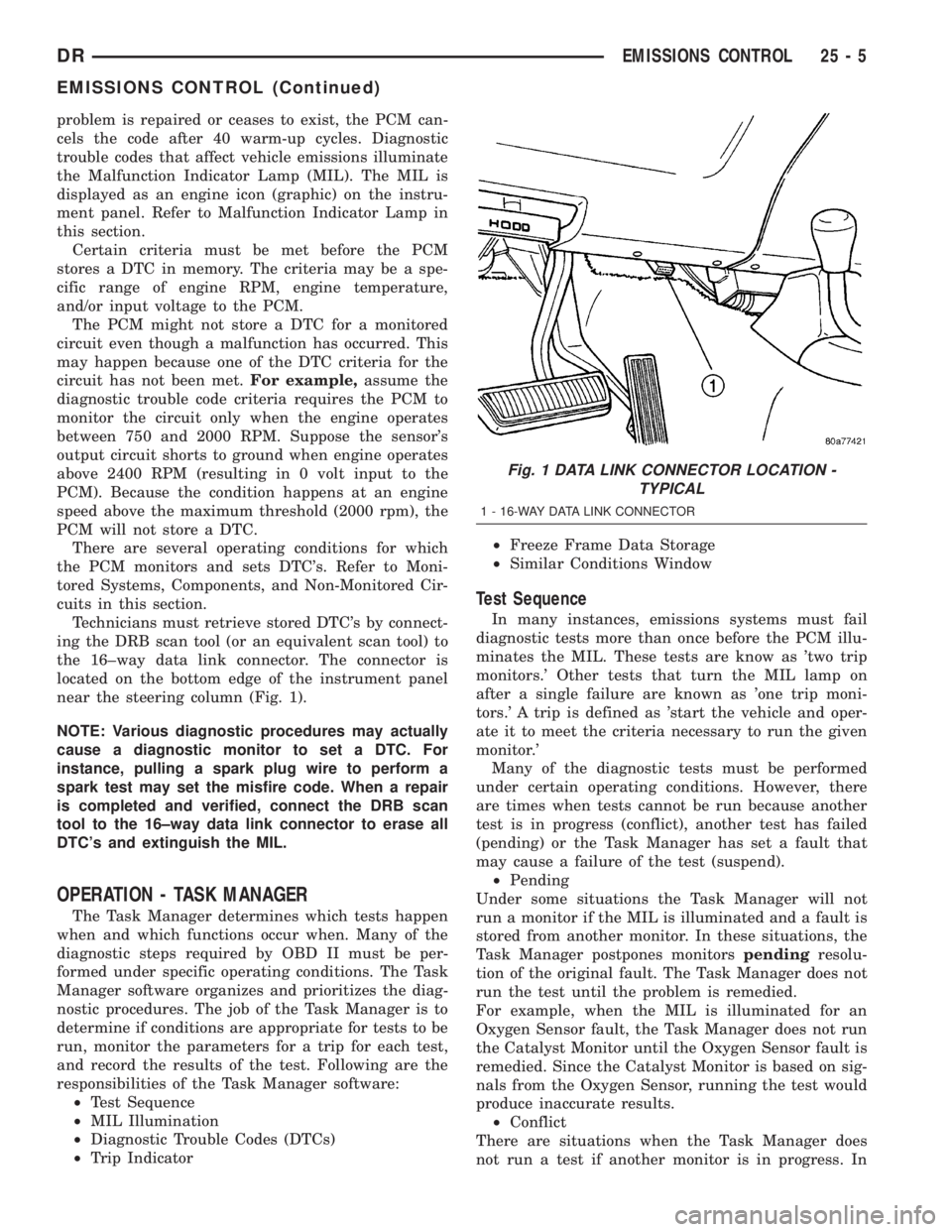
problem is repaired or ceases to exist, the PCM can-
cels the code after 40 warm-up cycles. Diagnostic
trouble codes that affect vehicle emissions illuminate
the Malfunction Indicator Lamp (MIL). The MIL is
displayed as an engine icon (graphic) on the instru-
ment panel. Refer to Malfunction Indicator Lamp in
this section.
Certain criteria must be met before the PCM
stores a DTC in memory. The criteria may be a spe-
cific range of engine RPM, engine temperature,
and/or input voltage to the PCM.
The PCM might not store a DTC for a monitored
circuit even though a malfunction has occurred. This
may happen because one of the DTC criteria for the
circuit has not been met.For example,assume the
diagnostic trouble code criteria requires the PCM to
monitor the circuit only when the engine operates
between 750 and 2000 RPM. Suppose the sensor's
output circuit shorts to ground when engine operates
above 2400 RPM (resulting in 0 volt input to the
PCM). Because the condition happens at an engine
speed above the maximum threshold (2000 rpm), the
PCM will not store a DTC.
There are several operating conditions for which
the PCM monitors and sets DTC's. Refer to Moni-
tored Systems, Components, and Non-Monitored Cir-
cuits in this section.
Technicians must retrieve stored DTC's by connect-
ing the DRB scan tool (or an equivalent scan tool) to
the 16±way data link connector. The connector is
located on the bottom edge of the instrument panel
near the steering column (Fig. 1).
NOTE: Various diagnostic procedures may actually
cause a diagnostic monitor to set a DTC. For
instance, pulling a spark plug wire to perform a
spark test may set the misfire code. When a repair
is completed and verified, connect the DRB scan
tool to the 16±way data link connector to erase all
DTC's and extinguish the MIL.
OPERATION - TASK MANAGER
The Task Manager determines which tests happen
when and which functions occur when. Many of the
diagnostic steps required by OBD II must be per-
formed under specific operating conditions. The Task
Manager software organizes and prioritizes the diag-
nostic procedures. The job of the Task Manager is to
determine if conditions are appropriate for tests to be
run, monitor the parameters for a trip for each test,
and record the results of the test. Following are the
responsibilities of the Task Manager software:
²Test Sequence
²MIL Illumination
²Diagnostic Trouble Codes (DTCs)
²Trip Indicator²Freeze Frame Data Storage
²Similar Conditions Window
Test Sequence
In many instances, emissions systems must fail
diagnostic tests more than once before the PCM illu-
minates the MIL. These tests are know as 'two trip
monitors.' Other tests that turn the MIL lamp on
after a single failure are known as 'one trip moni-
tors.' A trip is defined as 'start the vehicle and oper-
ate it to meet the criteria necessary to run the given
monitor.'
Many of the diagnostic tests must be performed
under certain operating conditions. However, there
are times when tests cannot be run because another
test is in progress (conflict), another test has failed
(pending) or the Task Manager has set a fault that
may cause a failure of the test (suspend).
²Pending
Under some situations the Task Manager will not
run a monitor if the MIL is illuminated and a fault is
stored from another monitor. In these situations, the
Task Manager postpones monitorspendingresolu-
tion of the original fault. The Task Manager does not
run the test until the problem is remedied.
For example, when the MIL is illuminated for an
Oxygen Sensor fault, the Task Manager does not run
the Catalyst Monitor until the Oxygen Sensor fault is
remedied. Since the Catalyst Monitor is based on sig-
nals from the Oxygen Sensor, running the test would
produce inaccurate results.
²Conflict
There are situations when the Task Manager does
not run a test if another monitor is in progress. In
Fig. 1 DATA LINK CONNECTOR LOCATION -
TYPICAL
1 - 16-WAY DATA LINK CONNECTOR
DREMISSIONS CONTROL 25 - 5
EMISSIONS CONTROL (Continued)
Page 2869 of 2895
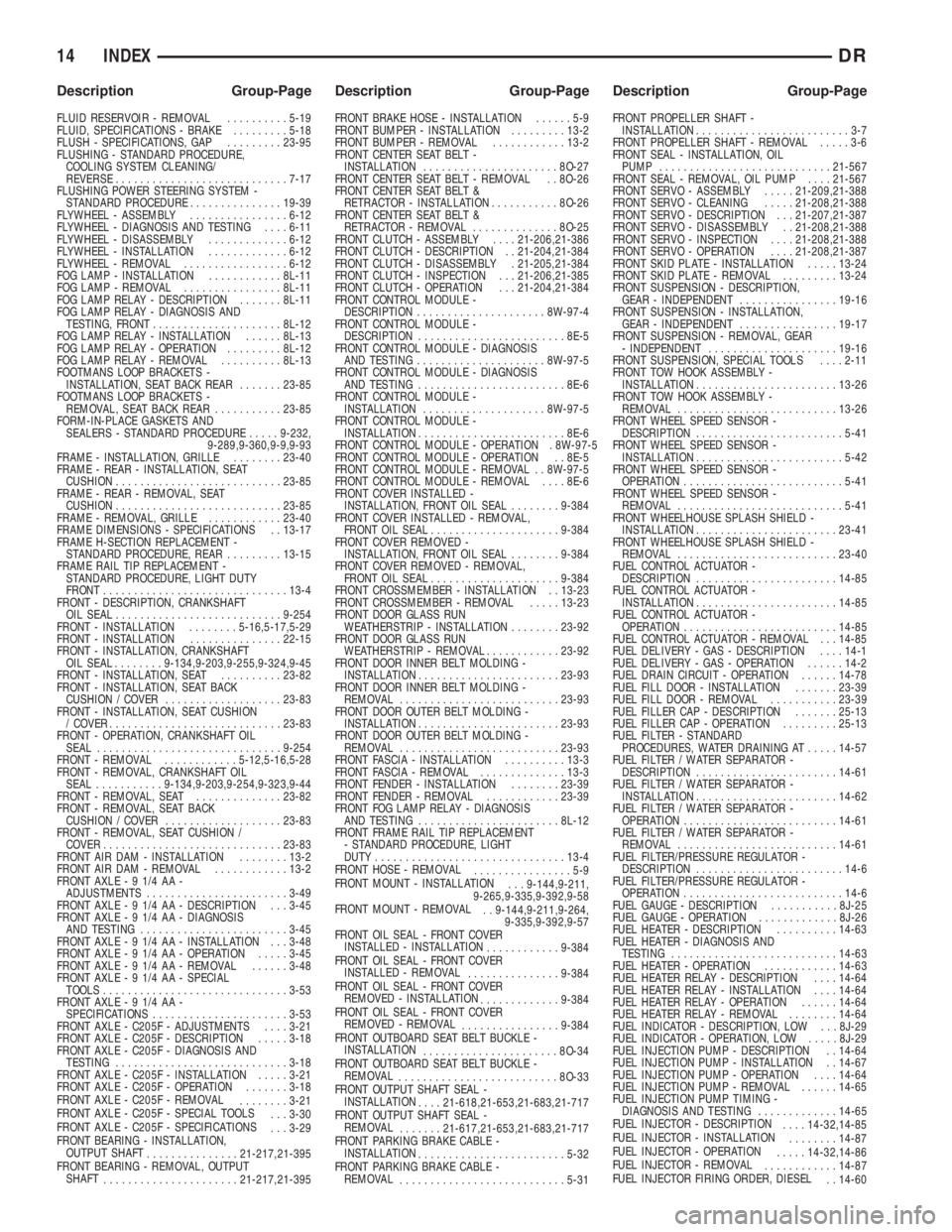
FLUID RESERVOIR - REMOVAL..........5-19
FLUID, SPECIFICATIONS - BRAKE.........5-18
FLUSH - SPECIFICATIONS, GAP.........23-95
FLUSHING - STANDARD PROCEDURE,
COOLING SYSTEM CLEANING/
REVERSE............................7-17
FLUSHING POWER STEERING SYSTEM -
STANDARD PROCEDURE...............19-39
FLYWHEEL - ASSEMBLY................6-12
FLYWHEEL - DIAGNOSIS AND TESTING....6-11
FLYWHEEL - DISASSEMBLY.............6-12
FLYWHEEL - INSTALLATION.............6-12
FLYWHEEL - REMOVAL.................6-12
FOG LAMP - INSTALLATION............8L-11
FOG LAMP - REMOVAL................8L-11
FOG LAMP RELAY - DESCRIPTION.......8L-11
FOG LAMP RELAY - DIAGNOSIS AND
TESTING, FRONT.....................8L-12
FOG LAMP RELAY - INSTALLATION......8L-13
FOG LAMP RELAY - OPERATION.........8L-12
FOG LAMP RELAY - REMOVAL..........8L-13
FOOTMANS LOOP BRACKETS -
INSTALLATION, SEAT BACK REAR.......23-85
FOOTMANS LOOP BRACKETS -
REMOVAL, SEAT BACK REAR...........23-85
FORM-IN-PLACE GASKETS AND
SEALERS - STANDARD PROCEDURE.....9-232,
9-289,9-360,9-9,9-93
FRAME - INSTALLATION, GRILLE........23-40
FRAME - REAR - INSTALLATION, SEAT
CUSHION...........................23-85
FRAME - REAR - REMOVAL, SEAT
CUSHION...........................23-85
FRAME - REMOVAL, GRILLE............23-40
FRAME DIMENSIONS - SPECIFICATIONS . . 13-17
FRAME H-SECTION REPLACEMENT -
STANDARD PROCEDURE, REAR.........13-15
FRAME RAIL TIP REPLACEMENT -
STANDARD PROCEDURE, LIGHT DUTY
FRONT..............................13-4
FRONT - DESCRIPTION, CRANKSHAFT
OIL SEAL...........................9-254
FRONT - INSTALLATION........5-16,5-17,5-29
FRONT - INSTALLATION...............22-15
FRONT - INSTALLATION, CRANKSHAFT
OIL SEAL........9-134,9-203,9-255,9-324,9-45
FRONT - INSTALLATION, SEAT..........23-82
FRONT - INSTALLATION, SEAT BACK
CUSHION / COVER...................23-83
FRONT - INSTALLATION, SEAT CUSHION
/ COVER............................23-83
FRONT - OPERATION, CRANKSHAFT OIL
SEAL..............................9-254
FRONT - REMOVAL............5-12,5-16,5-28
FRONT - REMOVAL, CRANKSHAFT OIL
SEAL...........9-134,9-203,9-254,9-323,9-44
FRONT - REMOVAL, SEAT..............23-82
FRONT - REMOVAL, SEAT BACK
CUSHION / COVER...................23-83
FRONT - REMOVAL, SEAT CUSHION /
COVER.............................23-83
FRONT AIR DAM - INSTALLATION........13-2
FRONT AIR DAM - REMOVAL............13-2
FRONT AXLE - 9 1/4 AA -
ADJUSTMENTS.......................3-49
FRONT AXLE - 9 1/4 AA - DESCRIPTION . . . 3-45
FRONT AXLE - 9 1/4 AA - DIAGNOSIS
AND TESTING........................3-45
FRONT AXLE - 9 1/4 AA - INSTALLATION . . . 3-48
FRONT AXLE - 9 1/4 AA - OPERATION.....3-45
FRONT AXLE - 9 1/4 AA - REMOVAL......3-48
FRONT AXLE - 9 1/4 AA - SPECIAL
TOOLS..............................3-53
FRONT AXLE - 9 1/4 AA -
SPECIFICATIONS......................3-53
FRONT AXLE - C205F - ADJUSTMENTS....3-21
FRONT AXLE - C205F - DESCRIPTION.....3-18
FRONT AXLE - C205F - DIAGNOSIS AND
TESTING............................3-18
FRONT AXLE - C205F - INSTALLATION.....3-21
FRONT AXLE - C205F - OPERATION.......3-18
FRONT AXLE - C205F - REMOVAL
........3-21
FRONT AXLE - C205F - SPECIAL TOOLS
. . . 3-30
FRONT AXLE - C205F - SPECIFICATIONS
. . . 3-29
FRONT BEARING - INSTALLATION,
OUTPUT SHAFT
...............21-217,21-395
FRONT BEARING - REMOVAL, OUTPUT
SHAFT
......................21-217,21-395FRONT BRAKE HOSE - INSTALLATION......5-9
FRONT BUMPER - INSTALLATION.........13-2
FRONT BUMPER - REMOVAL............13-2
FRONT CENTER SEAT BELT -
INSTALLATION......................8O-27
FRONT CENTER SEAT BELT - REMOVAL . . 8O-26
FRONT CENTER SEAT BELT &
RETRACTOR - INSTALLATION...........8O-26
FRONT CENTER SEAT BELT &
RETRACTOR - REMOVAL..............8O-25
FRONT CLUTCH - ASSEMBLY....21-206,21-386
FRONT CLUTCH - DESCRIPTION . . 21-204,21-384
FRONT CLUTCH - DISASSEMBLY . 21-205,21-384
FRONT CLUTCH - INSPECTION . . . 21-206,21-385
FRONT CLUTCH - OPERATION . . . 21-204,21-384
FRONT CONTROL MODULE -
DESCRIPTION.....................8W-97-4
FRONT CONTROL MODULE -
DESCRIPTION........................8E-5
FRONT CONTROL MODULE - DIAGNOSIS
AND TESTING.....................8W-97-5
FRONT CONTROL MODULE - DIAGNOSIS
AND TESTING........................8E-6
FRONT CONTROL MODULE -
INSTALLATION....................8W-97-5
FRONT CONTROL MODULE -
INSTALLATION........................8E-6
FRONT CONTROL MODULE - OPERATION . 8W-97-5
FRONT CONTROL MODULE - OPERATION . . 8E-5
FRONT CONTROL MODULE - REMOVAL . . 8W-97-5
FRONT CONTROL MODULE - REMOVAL....8E-6
FRONT COVER INSTALLED -
INSTALLATION, FRONT OIL SEAL........9-384
FRONT COVER INSTALLED - REMOVAL,
FRONT OIL SEAL.....................9-384
FRONT COVER REMOVED -
INSTALLATION, FRONT OIL SEAL........9-384
FRONT COVER REMOVED - REMOVAL,
FRONT OIL SEAL.....................9-384
FRONT CROSSMEMBER - INSTALLATION . . 13-23
FRONT CROSSMEMBER - REMOVAL.....13-23
FRONT DOOR GLASS RUN
WEATHERSTRIP - INSTALLATION........23-92
FRONT DOOR GLASS RUN
WEATHERSTRIP - REMOVAL............23-92
FRONT DOOR INNER BELT MOLDING -
INSTALLATION.......................23-93
FRONT DOOR INNER BELT MOLDING -
REMOVAL..........................23-93
FRONT DOOR OUTER BELT MOLDING -
INSTALLATION.......................23-93
FRONT DOOR OUTER BELT MOLDING -
REMOVAL..........................23-93
FRONT FASCIA - INSTALLATION..........13-3
FRONT FASCIA - REMOVAL..............13-3
FRONT FENDER - INSTALLATION........23-39
FRONT FENDER - REMOVAL............23-39
FRONT FOG LAMP RELAY - DIAGNOSIS
AND TESTING.......................8L-12
FRONT FRAME RAIL TIP REPLACEMENT
- STANDARD PROCEDURE, LIGHT
DUTY...............................13-4
FRONT HOSE - REMOVAL
................5-9
FRONT MOUNT - INSTALLATION
. . . 9-144,9-211,
9-265,9-335,9-392,9-58
FRONT MOUNT - REMOVAL
. . 9-144,9-211,9-264,
9-335,9-392,9-57
FRONT OIL SEAL - FRONT COVER
INSTALLED - INSTALLATION
............9-384
FRONT OIL SEAL - FRONT COVER
INSTALLED - REMOVAL
...............9-384
FRONT OIL SEAL - FRONT COVER
REMOVED - INSTALLATION
.............9-384
FRONT OIL SEAL - FRONT COVER
REMOVED - REMOVAL
................9-384
FRONT OUTBOARD SEAT BELT BUCKLE -
INSTALLATION
......................8O-34
FRONT OUTBOARD SEAT BELT BUCKLE -
REMOVAL
..........................8O-33
FRONT OUTPUT SHAFT SEAL -
INSTALLATION
....21-618,21-653,21-683,21-717
FRONT OUTPUT SHAFT SEAL -
REMOVAL
.......21-617,21-653,21-683,21-717
FRONT PARKING BRAKE CABLE -
INSTALLATION
........................5-32
FRONT PARKING BRAKE CABLE -
REMOVAL
...........................5-31FRONT PROPELLER SHAFT -
INSTALLATION.........................3-7
FRONT PROPELLER SHAFT - REMOVAL.....3-6
FRONT SEAL - INSTALLATION, OIL
PUMP............................21-567
FRONT SEAL - REMOVAL, OIL PUMP....21-567
FRONT SERVO - ASSEMBLY.....21-209,21-388
FRONT SERVO - CLEANING.....21-208,21-388
FRONT SERVO - DESCRIPTION . . . 21-207,21-387
FRONT SERVO - DISASSEMBLY . . 21-208,21-388
FRONT SERVO - INSPECTION....21-208,21-388
FRONT SERVO - OPERATION....21-208,21-387
FRONT SKID PLATE - INSTALLATION.....13-24
FRONT SKID PLATE - REMOVAL.........13-24
FRONT SUSPENSION - DESCRIPTION,
GEAR - INDEPENDENT................19-16
FRONT SUSPENSION - INSTALLATION,
GEAR - INDEPENDENT................19-17
FRONT SUSPENSION - REMOVAL, GEAR
- INDEPENDENT.....................19-16
FRONT SUSPENSION, SPECIAL TOOLS....2-11
FRONT TOW HOOK ASSEMBLY -
INSTALLATION.......................13-26
FRONT TOW HOOK ASSEMBLY -
REMOVAL..........................13-26
FRONT WHEEL SPEED SENSOR -
DESCRIPTION........................5-41
FRONT WHEEL SPEED SENSOR -
INSTALLATION........................5-42
FRONT WHEEL SPEED SENSOR -
OPERATION..........................5-41
FRONT WHEEL SPEED SENSOR -
REMOVAL...........................5-41
FRONT WHEELHOUSE SPLASH SHIELD -
INSTALLATION.......................23-41
FRONT WHEELHOUSE SPLASH SHIELD -
REMOVAL..........................23-40
FUEL CONTROL ACTUATOR -
DESCRIPTION.......................14-85
FUEL CONTROL ACTUATOR -
INSTALLATION.......................14-85
FUEL CONTROL ACTUATOR -
OPERATION.........................14-85
FUEL CONTROL ACTUATOR - REMOVAL . . . 14-85
FUEL DELIVERY - GAS - DESCRIPTION....14-1
FUEL DELIVERY - GAS - OPERATION......14-2
FUEL DRAIN CIRCUIT - OPERATION......14-78
FUEL FILL DOOR - INSTALLATION.......23-39
FUEL FILL DOOR - REMOVAL...........23-39
FUEL FILLER CAP - DESCRIPTION.......25-13
FUEL FILLER CAP - OPERATION.........25-13
FUEL FILTER - STANDARD
PROCEDURES, WATER DRAINING AT.....14-57
FUEL FILTER / WATER SEPARATOR -
DESCRIPTION.......................14-61
FUEL FILTER / WATER SEPARATOR -
INSTALLATION.......................14-62
FUEL FILTER / WATER SEPARATOR -
OPERATION.........................14-61
FUEL FILTER / WATER SEPARATOR -
REMOVAL..........................14-61
FUEL FILTER/PRESSURE REGULATOR -
DESCRIPTION........................14-6
FUEL FILTER/PRESSURE REGULATOR -
OPERATION..........................14-6
FUEL GAUGE - DESCRIPTION...........8J-25
FUEL GAUGE - OPERATION.............8J-26
FUEL HEATER - DESCRIPTION..........14-63
FUEL HEATER - DIAGNOSIS AND
TESTING...........................14-63
FUEL HEATER - OPERATION............14-63
FUEL HEATER RELAY - DESCRIPTION....14-64
FUEL HEATER RELAY - INSTALLATION....14-64
FUEL HEATER RELAY - OPERATION......14-64
FUEL HEATER RELAY - REMOVAL........14-64
FUEL INDICATOR - DESCRIPTION, LOW . . . 8J-29
FUEL INDICATOR - OPERATION, LOW.....8J-29
FUEL INJECTION PUMP - DESCRIPTION . . 14-64
FUEL INJECTION PUMP - INSTALLATION . . 14-67
FUEL INJECTION PUMP - OPERATION....14-64
FUEL INJECTION PUMP - REMOVAL......14-65
FUEL INJECTION PUMP TIMING -
DIAGNOSIS AND TESTING.............14-65
FUEL INJECTOR - DESCRIPTION
....14-32,14-85
FUEL INJECTOR - INSTALLATION
........14-87
FUEL INJECTOR - OPERATION
.....14-32,14-86
FUEL INJECTOR - REMOVAL
............14-87
FUEL INJECTOR FIRING ORDER, DIESEL
. . 14-60
14 INDEXDR
Description Group-Page Description Group-Page Description Group-Page